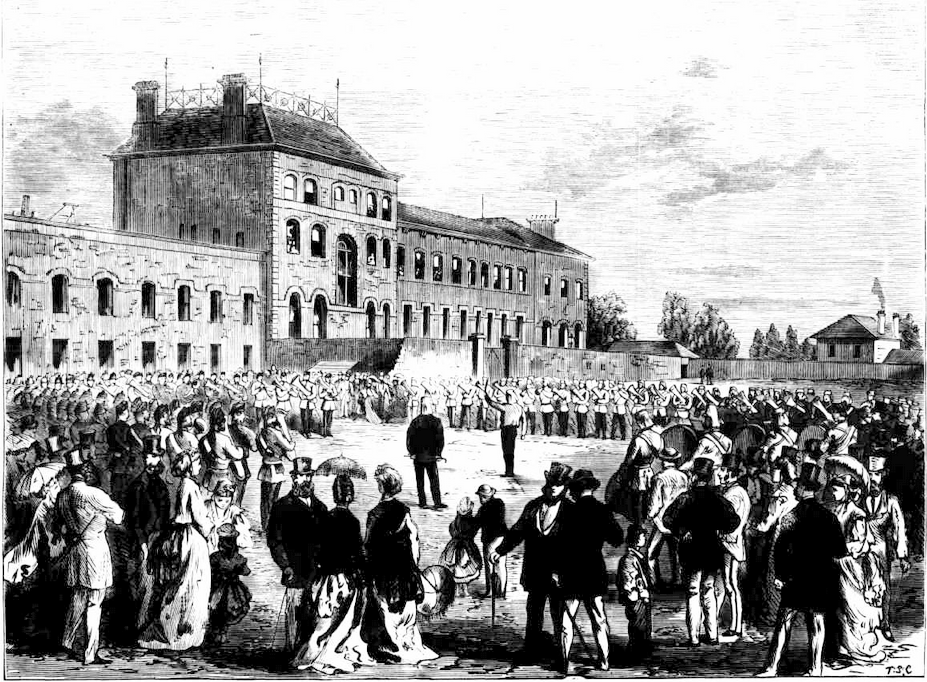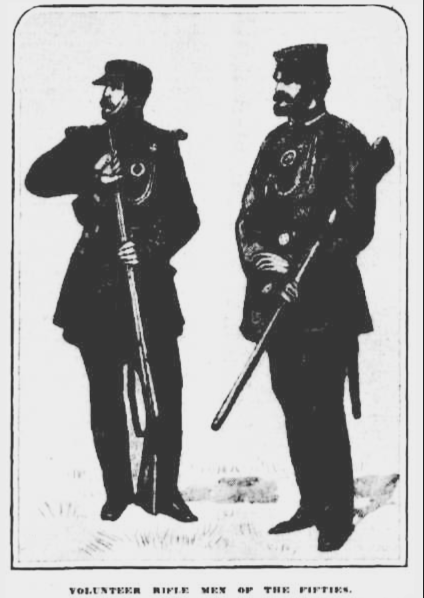“History of Defence Movement: Victoria’s First Soldiers by A.W. Greig”
This history was published on 6th April 1912 in the Melbourne newspaper, the Argus. The article is long, and the print faded, so I will transcribe it in installments. The punctuation, spelling, and lengthy sentences are as published. I have added some contemporary illustrations, as well as those included with the article. I found it interesting; I hope you do too.
The author, Alfred Woolley Greig (1873-1944), was a foundation member of the Historical Society of Victoria.

The Argus (Melbourne), 1st May 1944 page 4.
_____________________
Part 1
“The opening of the year 1854 saw black clouds gathered upon the European political horizon. Turkey had appealed to Great Britain and France for assistance against Russian aggression, and for six months the principal nations of eastern and western Europe had been on the verge of war. Six or seven months more passed before the outbreak of hostilities, but in the meantime the distant and isolated portions of the British Empire, forseeing the possibility of reprisals by Russia in which they would be affected, had begun to consider the expediency of taking active measures for their own protection.
The colony of Victoria was at this period garrisoned by about 700 Imperial troops, but was wholly without coast or harbour defences. A report made on the subject by Captain Ross, R.E. in January, 1854, led to the appointment of a select committee of the Legislative Council in the same month and subsequently the sum of £27.000 was voted for the purchase of a steam war-vessel. No notice, however, was taken of the committee’s recommendation that the regular forces in the colony should be supplemented by the enrolment of a volunteer rifle corps, and it was left to the colonists themselves to take the initiative in this direction. On Wednesday, June 7, 1854, a meeting was held at the Mechanics Institution for the purpose of forming a “Melbourne Rifle Corps”, and about the same time similar action was taken in Geelong, where some German residents seem to have taken the lead. It must be confessed that after the first patriotic speeches, and passing of resolutions, the movement hung fire a little: but in August, 1854, the transference of the headquarters of the Imperial forces from Sydney to Melbourne gave some little impetus to military matters, and we hear of a rifle club having been established in Belfast (Ed: now Port Fairy), and of renewed activities among the would-be soldiers of Geelong. it was not until the following October, however, that any definite progress was made in Melbourne. First of all, the empty formality of conferring on the Lieutenant-Governor the “Colonelcy-in-Chief” of a non-existent regiment had to be gone through; then came the swearing-in of future defenders at the City Police Court; and finally the introduction to the Legislative Council of a bill to give the volunteer force a legal standing. Sixty or seventy volunteers had been enrolled in Melbourne, while the Geelong corps boasted over a hundred members, and possessed a standard and standard-bearer. Not withstanding the dissatisfied growl of one member of the Council that “if the soldiering mania once got a hold of the people there would be no telling where it would stop,” an act authorising the enrolment of not more than two thousand volunteers was placed on the Statute Book on November 30, 1854, and on the same day Colonel W. A. D. Anderson was gazetted as lieutenant-colonel of the Melbourne Volunteer Rifle Regiment.
To the south of Prince’s Bridge, on the site now occupied by the buildings of the Victorian Hostel for the Aged and Infirm, stood some wooden structures which had been erected during the “Canvas Town” period (Ed: during the early gold rush) for the accommodation of homeless immigrants. These had been converted to military uses, and were known as the “Prince’s bridge Barracks” and here the “Rifle Brigade” was provided with official headquarters.

Illustrated Adelaide Post, 17th January 1871 page 4. Prince’s Bridge Barracks.
Accommodation for drill purposes had to be sought elsewhere, and for a week or two the hall of the Criterion Hotel, Collins street, was made use of, an arrangement soon interfered with by the conversion of this apartment into a music hall or “theatre”.

State Library Victoria image # 2028761Criterion Hotel, Collins Street, c 1850-59.
By this time the corps numbered about a hundred and twenty members, the average attending drills being sixty, and in January, 1855, they obtained the use of the then recently-vacated Exhibition building in William-street.

National Library image #8632665. The Exhibition Building, Melbourne, 1854 / lithographed by Cyrus Mason.
I am in debted to a survivor of this first body of citizen soldiers, who is still a well known and highly respected Melbourne resident, for some description of the uniform and arms of the corps. “Invisible green” was at the time considered the correct colour for the dress of a rifleman; but, as the exact shade required was not then available in Melbourne, a brighter “almost grass green” woollen cloth was utilised, cuffs and collars being braided with black. A cap, having a peak, and adorned with a white metal badge representing a bugle, completed the costume, of which a very good idea is given by our illustration. Amongst themselves these verdant heroes were familiarly known as the “Green Bays”. The latest development in rifles was at the time the “Minie”, a French Pattern, which had been first issued to some of the British regiments prior to their departure for the Crimea. Pending the arrival of a supply of these from England, the “riflemen” of Melbourne were armed with smooth-bored weapons, with brass-shod stocks.

(Frontispiece to “Rifle Volunteers”, by Captain Hans Busk )
The “awkward squad” stage having been passed, the Rifle Brigade, now divided into two companies, was inspected by the Lieutenant-Governor on March 2, 1855. About sixty only attended this parade, and the manoeuvres, which took place on the ground adjoining the Prince’s bridge Barracks, were by no means faultless; but one feels inclined to endorse the praise awarded by the contemporary press to “the gentlemen who have set this example and have exhibited the moral courage to bear the little ridicule which first attempts at soldering always provoke.” We cannot doubt that similar sentiments animated those officers of the permanent forces who were in attendance on this occasion, and that they restrained themselves from, any unkindly criticism; but a like self-control can hardly be credited to the steed of one of their number, who, as soon as he beheld these inexperienced amateurs handling and discharging firearms, bolted incontinently across Prince’ bridge. The only redeeming feature of this escapade was the fact that he very considerately deposited his rider close to the coroner’s office.
http://www.austbuttonhistory.com/28th-october-2020/
For all comments and questions, please use the Contact page.
